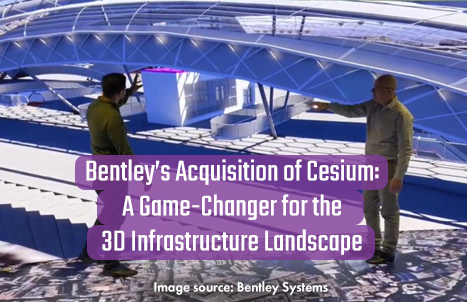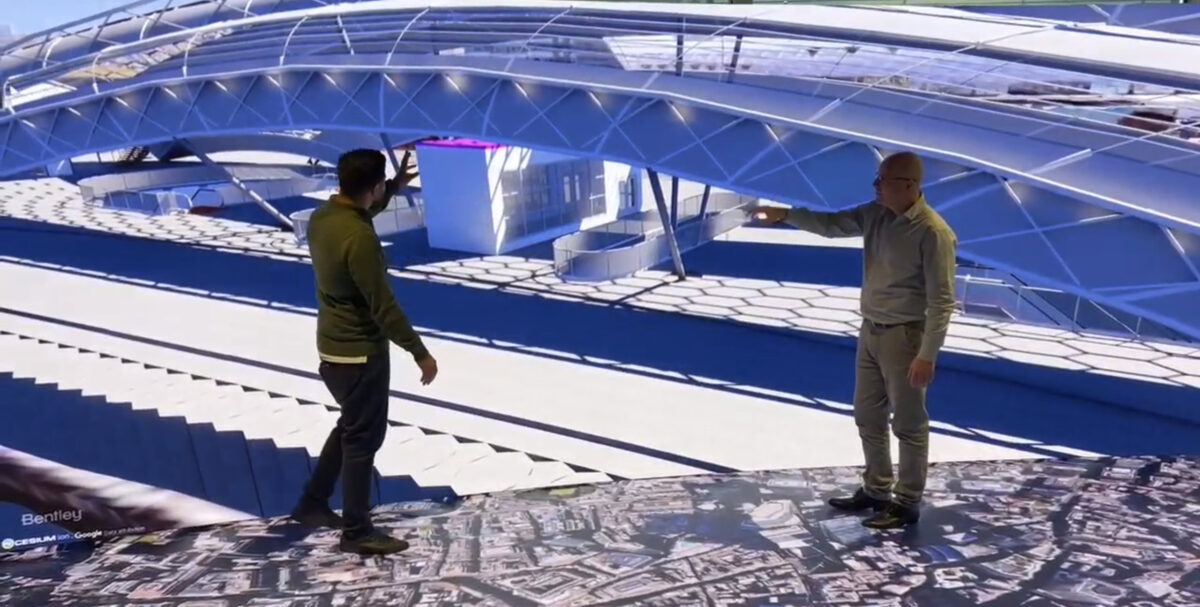

Bentley Systems’ acquisition of Cesium, a leading platform for real-time 3D geospatial data, marks a significant milestone in the convergence of infrastructure software and geospatial technology. By integrating Cesium’s advanced 3D visualization capabilities with Bentley’s digital twin and infrastructure management solutions, the acquisition aims to transform how we design, manage, and interact with infrastructure.
This strategic move aligns with a broader industry trend of combining cutting-edge technologies to enhance decision-making, efficiency, and project outcomes.
The acquisition comes as the geospatial industry experiences rapid growth driven by advancements in 3D visualization, digital twins, and real-time data analytics. Both Cesium and Bentley Systems have been pioneers in these areas, making their union a natural evolution for companies committed to next-generation solutions.
While mergers and acquisitions in the tech space are common, this one stands out not for its size but for the promise it holds in reshaping how we design, manage, and maintain infrastructure at a global scale.
A Natural Partnership
Founded in 2011, Cesium quickly established itself as a trailblazer in 3D geospatial technology with its web-based 3D rendering engine, CesiumJS. Originally developed for aerospace visualization, CesiumJS has expanded to applications in defense, urban planning, and entertainment. The technology allows users to visualize, analyze, and share geospatial data in an interactive 3D environment — a game-changer for industries that rely on high-fidelity data to make informed decisions.
Bentley Systems, on the other hand, has long been recognized as a leader in providing infrastructure engineering software. Bentley’s offerings range from design and construction solutions to performance modelling for civil engineering, water resources, and transportation sectors. Their emphasis on digital twins — virtual models of physical assets — has set them apart in the world of infrastructure, allowing users to monitor, analyze, and manage assets throughout their entire lifecycle.
Central to Bentley’s digital twin strategy is the iTwin platform, which facilitates real-time visualization and interaction with 3D models, thereby enhancing decision-making and operational efficiency. Bentley’s commitment to integrating real-time data, geospatial information, and 3D modelling continues to advance sustainability and efficiency in infrastructure projects worldwide.
Merging Capabilities: The Power of 3D Digital Twins
At the core of this partnership is the integration of real-time 3D geospatial technology with digital twins — virtual representations of real-world objects and environments. While digital twins have been around for some time, the ability to render them in true 3D, complete with real-time updates and vast geospatial datasets, represents a leap forward for many industries.
The integration of Cesium’s 3D engine with Bentley’s infrastructure-focused tools will change this by enabling the creation of digital twins that are far more immersive, scalable, and data-rich, enabling users to make more informed decisions during every phase of a project’s lifecycle — from design and construction to maintenance and operation.
For infrastructure projects, this means that engineers, architects, and planners will be able to interact with digital models of their projects that are fully immersed in real-world geographic contexts. This capability is particularly important in areas like urban planning, where decision-makers need to account for multiple, interrelated systems, such as water management, energy grids, and transportation networks. This dynamic model can be updated in real-time with satellite, drone, and sensor data.
As cities and companies face mounting pressure to become more resilient and adaptive in the face of climate change, this development promises deeper insights into how infrastructure interacts with both natural and urban environments and anticipates challenges before they arise.
Open Standards: A Critical Component
One of the most significant aspects of this merger lies in Cesium’s commitment to open standards — a cornerstone of its platform. Cesium has long championed interoperability in the geospatial sector, emphasizing the need for technologies that work across different platforms and devices. The 3D Tiles format, which Cesium pioneered, has emerged as an open standard for streaming massive 3D geospatial datasets widely used across industries.
By joining Bentley, Cesium is expected to push this open standard even further, integrating it into Bentley’s digital twin offerings. This could mark a significant shift for the industry, where proprietary formats often lead to data silos and limited collaboration between tools. For governments, engineering firms, and urban planners who rely on multi-platform workflows, this open standards approach will enable better cross-industry collaboration and data sharing.
This aligns with the broader push towards democratizing geospatial data, potentially allowing more stakeholders — from small engineering firms to large government agencies — to access and utilize 3D geospatial data in ways that are more flexible and cost-effective.
Shaping the Future of Infrastructure
Bentley Systems has continuously expanded its technology portfolio through strategic acquisitions, enhancing its capabilities and broadening its offerings. Recent additions include Power Line Systems (2021), Seequent (2021), SPIDA Software (2021), ADINA R&D (2022), eagle.io (2022) and EasyPower (2023).
The acquisition of Cesium, however, stands out for its unique strategic purpose. While the others add to Bentley’s advanced engineering and geotechnical capabilities to Bentley, Cesium specifically boosts Bentley’s 3D geospatial data and visualization capabilities, particularly for digital twins and infrastructure projects.
Recent developments in the geospatial industry highlight a trend toward integrating advanced technologies to elevate infrastructure planning, management, and visualization. In 2024, Trimble and Esri strengthened their long-standing partnership to enhance construction and infrastructure management, focusing on deeper technology integration and improved GIS workflow efficiency for sustainable planning. Similarly, Esri and Autodesk have collaborated closely to enhance interoperability between their platforms, streamlining workflows for infrastructure projects and enhancing the ability to create comprehensive digital twins, optimize project outcomes, and support sustainable infrastructure development.
The Bentley-Cesium partnership exemplifies the future direction of the geospatial and infrastructure sectors: greater integration, real-time intelligence, and adherence to open standards. This collaboration reflects a broader trend toward combining digitalization with geospatial intelligence. For instance, a study by McKinsey & Company highlights how digital twins and real-time data integration are revolutionizing infrastructure management. Furthermore, a report from Gartner underscores the accelerating adoption of geospatial intelligence across various sectors. It reveals that businesses integrating geospatial data with digital technologies are experiencing enhanced operational efficiency and new revenue streams.
This partnership not only aligns with these trends but also has the potential to reshape industries such as architecture, construction, engineering, and urban planning. While the full impact will take time to fully realize, early indications suggest this collaboration could redefine the way we plan, oversee, and engage with our environment.
As the geospatial and infrastructure industries closely watch this development, one thing is certain: the future of 3D geospatial technology is set to become even more exciting.





Be the first to comment